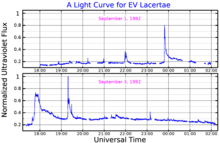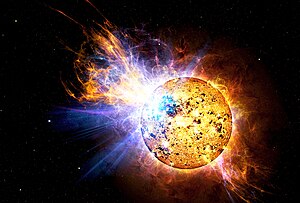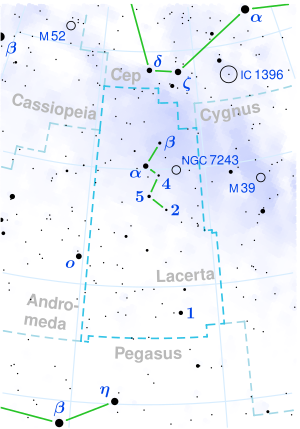| Observation data Epoch J2000 Equinox J2000 | |
|---|---|
| Constellation | Lacerta |
| Right ascension | 22h 46m 49.73126s[1] |
| Declination | +44° 20′ 02.3744″[1] |
| Apparent magnitude (V) | 10.26[2] |
| Characteristics | |
| Spectral type | M3.5[3] |
| U−B color index | +0.83[4] |
| B−V color index | +1.36[4] |
| Variable type | Flare star |
| Astrometry | |
| Radial velocity (Rv) | −0.23±0.17[1] km/s |
| Proper motion (μ) | RA: –706.216 mas/yr[1] Dec.: –458.920 mas/yr[1] |
| Parallax (π) | 197.9573 ± 0.0220 mas[1] |
| Distance | 16.476 ± 0.002 ly (5.0516 ± 0.0006 pc) |
| Details | |
| Mass | 0.32±0.008[5] M☉ |
| Radius | 0.331±0.013[5] R☉ |
| Temperature | 3370+75 −71[5] K |
| Metallicity [Fe/H] | –0.01 ± 0.17[6] dex |
| Rotation | 4.3715±0.0006 d[7] |
| Rotational velocity (v sin i) | 4.5[8] km/s |
| Other designations | |
| Database references | |
| SIMBAD | data |
Location of EV Lacertae in the constellation Lacerta | |
EV Lacertae (EV Lac, Gliese 873, HIP 112460) is a faint red dwarf star 16.48 light-years away in the constellation Lacerta. It is the nearest star to the Sun in that region of the sky, although with an apparent magnitude of 10, it is only barely visible with binoculars. EV Lacertae is a spectral type M3.5 flare star that emits X-rays.[9]

On 25 April 2008, NASA's Swift satellite picked up a record-setting flare from EV Lacertae.[11] This flare was thousands of times more powerful than the largest observed solar flare. Because EV Lacertae is much farther from Earth than the Sun, the flare did not appear as bright as a solar flare. The flare would have been visible to the naked eye if the star had been in an observable part of the night sky at the time. It was the brightest flare ever seen from a star other than the Sun.
EV Lacertae is much younger than that of the Sun. Its age is estimated at 300 million years, and it is still spinning rapidly. The fast spin, together with its convective interior, produces a magnetic field much more powerful than that of the Sun. This strong magnetic field is believed to play a role in the star's ability to produce such bright flares. After the flare, the star was blue.[12]
In October 2022, another stellar flare was observed in EV Lacertae by a group of scientists led by Shun Inoue of Kyoto University, after observing the star in near-ultraviolet and white-light curves.[13] The finding was announced and detailed in December 31, 2023, in the pre-print server arXiv.[13]
- ^ a b c d e Cite error: The named reference
GaiaDR3was invoked but never defined (see the help page). - ^ a b Cite error: The named reference
simbadwas invoked but never defined (see the help page). - ^ Cite error: The named reference
mnras3218_1_45was invoked but never defined (see the help page). - ^ a b Cite error: The named reference
bit6_143was invoked but never defined (see the help page). - ^ a b c Cite error: The named reference
Pineda2021was invoked but never defined (see the help page). - ^ Cite error: The named reference
apj748_2_934was invoked but never defined (see the help page). - ^ Cite error: The named reference
Morin2008was invoked but never defined (see the help page). - ^ Cite error: The named reference
apj646_1_L73was invoked but never defined (see the help page). - ^ Cite error: The named reference
Schmittwas invoked but never defined (see the help page). - ^ Cite error: The named reference
Abdul1995was invoked but never defined (see the help page). - ^ Cite error: The named reference
nasa1087was invoked but never defined (see the help page). - ^ "- YouTube". YouTube.
- ^ a b Nowakowski, Tomasz; Phys.org. "New large stellar flare detected from EV Lacertae". phys.org. Retrieved 2024-01-11.

